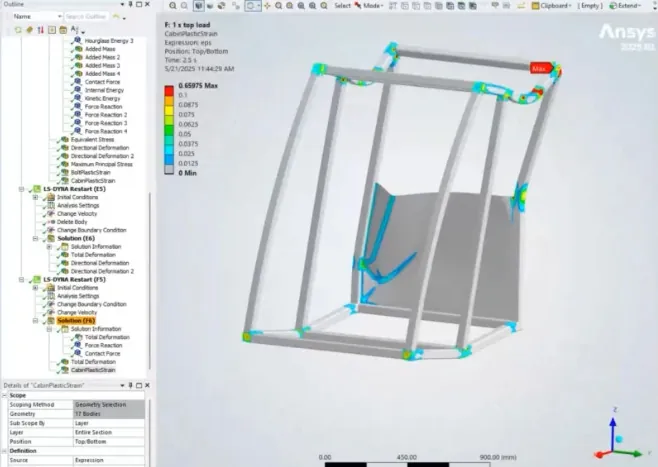Mastering Quasi-Static Analysis with LS-Dyna: A Comprehensive Guide

Quasi-static analysis has become an essential tool in modern engineering simulation. By modeling how loads are applied gradually, it minimizes inertial effects and replicates conditions close to static equilibrium. This allows engineers to study slow-evolving physical phenomena with precision and confidence.
While implicit solvers are often the go-to method, explicit methods offer unique advantages, particularly in handling highly nonlinear or complex simulations. In this guide, we’ll explore how Ansys LS-Dyna, a multiphysics solver renowned for its versatility, empowers engineers to master quasi-static analysis.
Originally developed for explicit dynamic analysis, LS-Dyna has grown into a robust multiphysics simulation package. Today, it enables engineers to integrate structural, fluid, thermal, and electromagnetic domains into a single workflow.
Key features of LS-Dyna include:
This seamless coupling makes LS-Dyna indispensable in industries such as automotive, aerospace, civil engineering, and biomechanics.
The choice of time integration scheme is central to any simulation:
Quasi-static analysis bridges the gap between static and dynamic simulation. It models slow load applications where acceleration and velocity remain minimal, ensuring inertial effects are negligible.
To achieve accurate quasi-static results using explicit methods, engineers must carefully manage inertial suppression:
Real-world systems often carry initial stresses before main loads are applied. LS-Dyna supports various preloading strategies:
Dynamic relaxation is particularly useful for minimizing noise and creating a clean transition into the main analysis.
One of LS-Dyna’s standout features is its restart analysis capability, enabling simulations to be paused, modified, and resumed without starting from scratch.
Types of restart include:
Verification is crucial. Engineers should confirm quasi-static conditions by monitoring:
Quasi-static analysis with LS-Dyna offers engineers:
Applications span industries, from crash safety (ROPS) and civil infrastructure to biomechanics and advanced material testing.
Quasi-static analysis redefines how engineers approach slow-moving scenarios, bridging the static and dynamic realms. With its advanced solver options, multiphysics integration, and restart workflows, Ansys LS-Dyna stands as a powerful platform for tackling today’s most complex engineering challenges.
Whether simulating rollover protection, civil infrastructure collapse, or biomechanical load histories, and much more, mastering these principles empowers engineers to unlock new levels of precision.
Find out more about Ansys LS-Dyna
Watch our webinar, ‘Coffee with an Expert: Quasi static simulations using Ansys LS-Dyna’, on-demand
